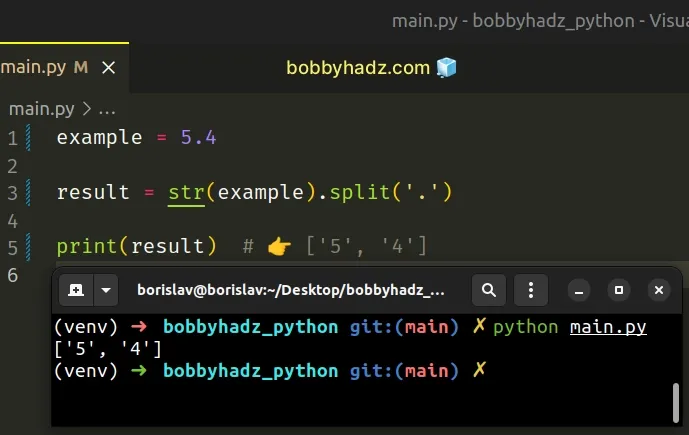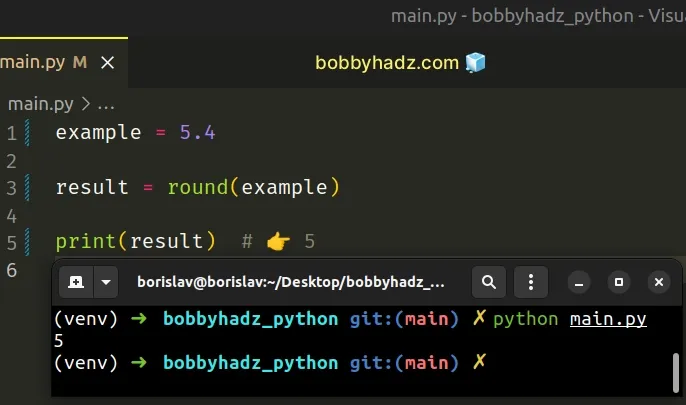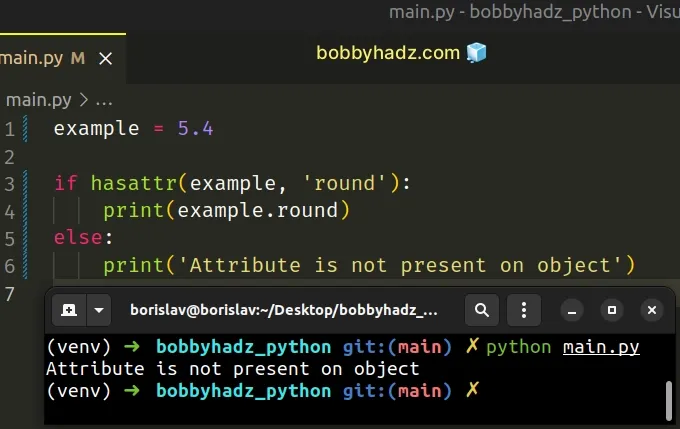AttributeError: 'float' object has no attribute 'X' (Python)
Last updated: Apr 8, 2024
Reading time·3 min

# AttributeError: 'float' object has no attribute 'X' (Python)
The Python "AttributeError: 'float' object has no attribute" occurs when we
try to access an attribute that doesn't exist on a floating-point number, e.g.
5.4.
To solve the error, make sure the value is of the expected type before accessing the attribute.

# Calling split() on a floating-point number
Here is an example of how the error occurs.
example = 5.4 print(type(example)) # 👉️ <class 'float'> # ⛔️ AttributeError: 'float' object has no attribute 'split' result = example.split('.') print(result)

We tried to call the split() method on a floating-point number and got the error.
If you print() the value you are accessing the attribute on, it will be a float.
To solve the error in the example, we have to convert the floating-point number
to a string to be able to access the string-specific split() method.
example = 5.4 result = str(example).split('.') print(result) # 👉️ ['5', '4']

# Calling round() on a floating-point number
Another common cause of the error is calling a round() method on a float.
example = 3.6 # ⛔️ AttributeError: 'float' object has no attribute 'round' result = example.round()

To solve the error, we have to pass the float as an argument to the round()
function, not call the function on the float.
example = 5.4 result = round(example) print(result) # 👉️ 5

Instead of accessing the round() function on the float, e.g.
example.round(), we have to pass the floating point number as an argument to
the round() function.
The round function takes the following 2 parameters:
| Name | Description |
|---|---|
number | the number to round to ndigits precision after the decimal |
ndigits | the number of digits after the decimal the number should have after the operation (optional) |
The round function returns the number rounded to ndigits precision after the
decimal point.
If ndigits is omitted, the function returns the nearest integer.
round() function on the float, e.g.my_float.round(), we have to pass the floating point number as an argument to the round() function, e.g. round(3.5).# Check if an object contains an attribute
If you need to check whether an object contains an attribute, use the hasattr
function.
example = 5.4 if hasattr(example, 'round'): print(example.round) else: print('Attribute is not present on object') # 👉️ This runs

The hasattr() function takes the following 2 parameters:
| Name | Description |
|---|---|
object | The object we want to test for the existence of the attribute |
name | The name of the attribute to check for in the object |
The hasattr() function returns True if the string is the name of one of the
object's attributes, otherwise False is returned.
hasattr function would handle the error if the attribute doesn't exist on the object, however, you still have to figure out where the variable gets assigned a float value in your code.# Figure out where the variable got assigned a floating-point number
A good way to start debugging is to print(dir(your_object)) and see what
attributes the object has.
Here is an example of what printing the attributes of a float looks like.
example = 5.4 # [..., 'as_integer_ratio', 'conjugate', 'fromhex', 'hex', 'imag', 'is_integer', 'real', ...] print(dir(example))
If you pass a class to the dir() function, it returns a list of names of the class's attributes, and recursively of the attributes of its bases.
If you try to access any attribute that is not in this list, you will get the error.
To solve the error, either convert the value to the correct type before accessing the attribute, or correct the type of the value you are assigning to the variable before accessing any attributes.

